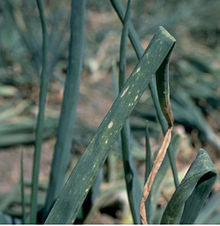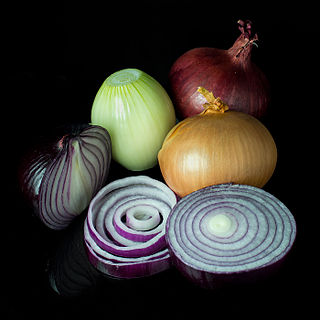
An onion, also known as the bulb onion or common onion, is a vegetable that is the most widely cultivated species of the genus Allium. The shallot is a botanical variety of the onion which was classified as a separate species until 2011. Its close relatives include garlic, scallion, leek, and chive.

Botrytis cinerea is a necrotrophic fungus that affects many plant species, although its most notable hosts may be wine grapes. In viticulture, it is commonly known as "botrytis bunch rot"; in horticulture, it is usually called "grey mould" or "gray mold".
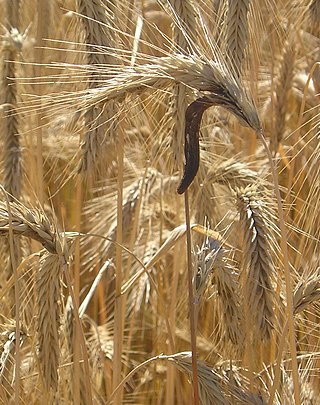
A sclerotium, is a compact mass of hardened fungal mycelium containing food reserves. One role of sclerotia is to survive environmental extremes. In some higher fungi such as ergot, sclerotia become detached and remain dormant until favorable growth conditions return. Sclerotia initially were mistaken for individual organisms and described as separate species until Louis René Tulasne proved in 1853 that sclerotia are only a stage in the life cycle of some fungi. Further investigation showed that this stage appears in many fungi belonging to many diverse groups. Sclerotia are important in the understanding of the life cycle and reproduction of fungi, as a food source, as medicine, and in agricultural blight management.
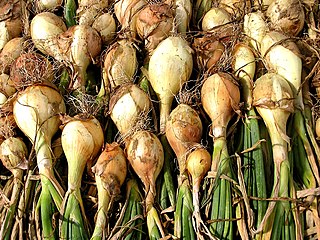
White onion or Allium cepa are a cultivar of dry onion which have a distinct light and mild flavour profile. Much like red onions, they have a high sugar and low sulphur content, and thus have a relatively short shelf life. White onions are used in a variety of dishes, such as those of Mexican and European origin. Their uses in dishes often relate to their mild nature, they are often included in dishes to provide a light, fresh and sour taste to dishes and are often added uncooked to dishes such as salads.

Botryotinia is a genus of ascomycete fungi causing several plant diseases. The anamorphs of Botryotinia are mostly included in the "imperfect fungi" genus Botrytis. The genus contains 22 species and one hybrid.

Monilinia fructicola is a species of fungus in the order Helotiales. A plant pathogen, it is the causal agent of brown rot of stone fruits.

Rhizoctonia solani is a species of fungus in the order Cantharellales. Basidiocarps are thin, effused, and web-like, but the fungus is more typically encountered in its anamorphic state, as hyphae and sclerotia. The name Rhizoctonia solani is currently applied to a complex of related species that await further research. In its wide sense, Rhizoctonia solani is a facultative plant pathogen with a wide host range and worldwide distribution. It causes various plant diseases such as root rot, damping off, and wire stem. It can also form mycorrhizal associations with orchids.
Glomerella graminicola is an economically important crop parasite affecting both wheat and maize where it causes the plant disease Anthracnose Leaf Blight.
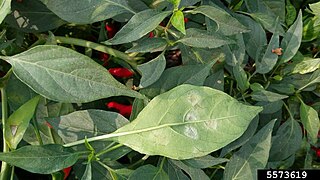
Leveillula taurica is an obligate fungal pathogen, from the phylum Ascomycota, which causes powdery mildew on onion. This disease prefers warm, dry environments. It is rare in the United States, and is currently restricted to western states. Globally, it is also a minor problem with limited occurrences in the Middle East, Europe, and South America. L. taurica causes powdery mildew of onions, but is also known to infect other allium, solanaceous, and cucurbit species. The disease has appeared in parts of the Middle East, the Mediterranean, and South and North America. Currently, it is not a cause for major concern in the U.S. and throughout the world, as its geographic extent is sparse. In addition, it is relatively easy to control through basic sanitation and reducing water stress.

Ascochyta is a genus of ascomycete fungi, containing several species that are pathogenic to plants, particularly cereal crops. The taxonomy of this genus is still incomplete. The genus was first described in 1830 by Marie-Anne Libert, who regarded the spores as minute asci and the cell contents as spherical spores. Numerous revisions to the members of the genus and its description were made for the next several years. Species that are plant pathogenic on cereals include, A. hordei, A. graminea, A. sorghi, A. tritici. Symptoms are usually elliptical spots that are initially chlorotic and later become a necrotic brown. Management includes fungicide applications and sanitation of diseased plant tissue debris.
Mycosphaerella cruenta, also called Pseudocercosopora cruenta in its asexual stage, is a fungal plant pathogen belonging to the group Ascomycota. It can affect several legume plants, including species of Phaseolus, Vigna, Calopogonium, Lablab niger, Mucuna and Stizolobium deeringianum [Mucuna pruriens][2]. It causes cowpea cercospora leaf spot, one of the most widespread and significant plant diseases in Africa and Asia. A city in China reported a 100% Mycosphaerella cruenta infection rate on cowpea in 2014[5]. In Africa, an epidemic can cause a yield loss of up to 40% [3].
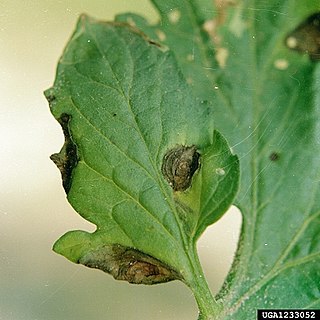
Alternaria solani is a fungal pathogen that produces a disease in tomato and potato plants called early blight. The pathogen produces distinctive "bullseye" patterned leaf spots and can also cause stem lesions and fruit rot on tomato and tuber blight on potato. Despite the name "early," foliar symptoms usually occur on older leaves. If uncontrolled, early blight can cause significant yield reductions. Primary methods of controlling this disease include preventing long periods of wetness on leaf surfaces and applying fungicides. Early blight can also be caused by Alternaria tomatophila, which is more virulent on stems and leaves of tomato plants than Alternaria solani.
This article summarizes different crops, what common fungal problems they have, and how fungicide should be used in order to mitigate damage and crop loss. This page also covers how specific fungal infections affect crops present in the United States.

Peronospora destructor is a plant pathogen. It causes downy mildew on leaves of cultivated and wild Allium. Allium cepa is most often affected, while Allium schoenoprasum (chives) and Allium porrum (leek) are only occasionally affected.
Stromatinia cepivora is a fungus in the division Ascomycota. It is the teleomorph of Sclerotium cepivorum, the cause of white rot in onions, garlic, and leeks. The infective sclerotia remain viable in the soil for many years and are stimulated to germinate by the presence of a susceptible crop.

Botrytis is a genus of anamorphic fungi in the family Sclerotiniaceae. Botrytis belongs to the group hyphomycetes and has about 30 different species. It is a plant parasite as well as saprophytes on both agricultural and forest trees. It produces stout, dark, branching conidiophores that bear clusters of paler conidia on denticles from apical ampullae. It is a common outdoor fungus and can be detected in spore trap samples. The fungus is often found growing on indoor plants. Although no mycotoxin has been reported from this fungus, it may cause hay fever, asthma and keratomycosis. The most common species is B. cinerea, which is a plant pathogen causing gray mould on a very broad range of hosts including some common ornamental plants, such as geranium, begonia, rose, lily, dogwood, rhododendron, dahlia, magnolia, camellia and fruits and produce. This fungus is mainly of outdoor origin, although it may be from growth on fruits or flowers brought in from outdoors. Some houseplants can be infected by this fungus, such as cyclamen, poinsettia, chrysanthemum, and gerbera. Other species of Botrytis may be present, such as B. peoniae on peonies, B. squamosa on onion, and B. tulipae on tulips. These species of Botrytis share some common characteristics in pathology and ecology.
A species of the genus of Penicillium which causes Blue Mold of Garlic on Allium sativum L. The genus name is derived from the Latin root penicillum, meaning "painter's brush", and refers to the chains of conidia this fungus produces that resemble a broom.

Botrytis squamosa is a fungus that causes leaf blight on onion that is distinctly characterized by the two stages – leaf spotting followed by blighting. The pathogen is an ascomycete that belongs to the family Sclerotiniaceae in the order Helotiales. The lesions start out as whitish streaks and take on a yellow tinge as they mature. They cause yield losses up to 30%. This fungus is endemic to the USA and has also been reported in Europe, Asia, and Australia. Typical management of this disease includes chemical fungicides with significant efforts being made to establish a means of biological control.

Alternaria brassicicola is a fungal necrotrophic plant pathogen that causes black spot disease on a wide range of hosts, particularly in the genus of Brassica, including a number of economically important crops such as cabbage, Chinese cabbage, cauliflower, oilseeds, broccoli and canola. Although mainly known as a significant plant pathogen, it also contributes to various respiratory allergic conditions such as asthma and rhinoconjunctivitis. Despite the presence of mating genes, no sexual reproductive stage has been reported for this fungus. In terms of geography, it is most likely to be found in tropical and sub-tropical regions, but also in places with high rain and humidity such as Poland. It has also been found in Taiwan and Israel. Its main mode of propagation is vegetative. The resulting conidia reside in the soil, air and water. These spores are extremely resilient and can overwinter on crop debris and overwintering herbaceous plants.

Botrytis elliptica is a necrotrophic fungal pathogen which infects species of plants in the Lilium genus, causing the disease commonly known as Lily Gray Mold. The symptoms of Lily Gray Mold include the appearance of water-soaked spots on leaves which appear white and increase in darkness with age, ranging from gray to brown. These spots may cover the entire leaf, complemented with a gray webbing, containing the fungal spores. The leaves will appear wilted and branches may die back. In addition to leaves, petals, stems, and buds may be infected, and this gray webbing will eventually cover the plant, feigning the appearance of gray flowers. Infected buds often rot. Lily Gray Mold disease, if not properly treated, will appear each year with increasing vigor.
